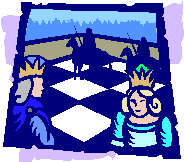
Game of life: Biocomputers take their first step with a little chess puzzle
A computer built from RNA has solved a chess problem. Its success is a step forward for nucleic acid computers, which are increasingly being touted as a future alternative to silicon chips.
DNA-based computers have caused a stir because unlike normal computers, they can, in theory, test massive amounts of solutions simultaneously (New Scientist, 13 July 1996, p 26).
Laura Landweber and her colleagues at Princeton University decided to build a computer based on RNA, which is made up of strings of bases similar to DNA's. The task they chose for it was a chess problem: list all the possible arrangements of any number of knights on a chessboard so that no knight is threatening another. There are more than 1019 possible arrangements of knights on a normal board, so the researchers started with a nine-square board, for which there are only 512 arrangements.
|
Problem
solved: 3 of the 31 solutions to the knight conundrum found by
the RNA-based machine
|
To represent these arrangements, they designed an RNA molecule with 10 unique 15-nucleotide sequences, separated by short spacers. Each sequence encodes the state--"knight on" or "knight off"--for one of the nine squares, along with information specifying which square it refers to.
This means that the 15-nucleotide representing a knight in position 1, for example, is different from the sequence for a knight in position 2. Having unique sequences for each position is the key to the computer. The tenth sequence was added as back-up.
To operate the computer, the researchers started with RNAs representing all 512 possible arrangements of knights. They pooled these RNAs and divided the pool into two samples.
In one, they destroyed all the molecules in which position 1 was "on" by adding a complementary 15-nucleotide DNA strand, which sticks to the targeted RNA sequence. Then they added the enzyme RNase H, which chews up RNA/DNA hybrids but leaves normal RNA alone.
In the other, they also destroyed all the molecules in which either position 6 or position 8 was on--the two positions from which a knight can attack square 1. The remixed pool represented chessboards in which space 1 was empty whenever a knight was present in either space 6 or 8.
After repeating the same operation with every other pair of mutually exclusive board positions, the researchers analysed what they had left. The 43 molecules they chose at random included 31 of the 94 possible solutions, and only one was wrong.
Junghuei Chen, a DNA computer researcher at the University of Delaware, says that such devices are unlikely to outcompete silicon in computations such as the knight problem. A more likely application, he says, will be in game theory algorithms, which involve selecting optimum strategies from a vast range of possibilities.